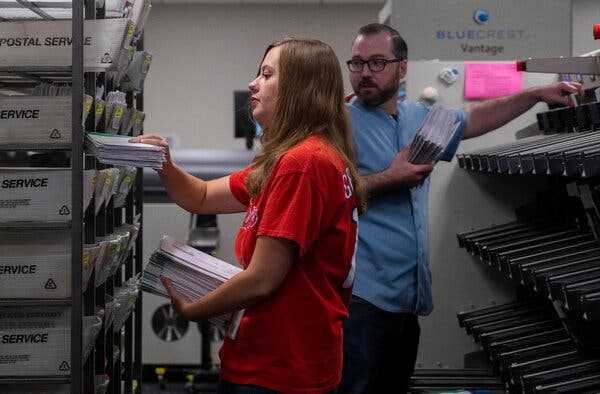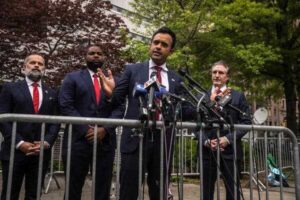Declining trust in institutions is fostering mistrust about voting, leading many Americans to embrace conspiracy theories about elections.
-
Send any friend a story
As a subscriber, you have 10 gift articles to give each month. Anyone can read what you share.
Give this articleGive this articleGive this article

Ballots in Bucks County, Pa., were stored after being recorded last month. Election conspiracy theories have flourished in Pennsylvania since the 2020 presidential contest.
A recent exchange between David Becker, a nonpartisan elections expert, and a Twitter user named “@catturd2” — an account with nearly a million followers that sometimes exchanges posts with Elon Musk, the world’s richest man and the new owner of Twitter — offered a telling example of why misinformation is such an intractable problem.
“Funny how we could easily count every vote in every state on election night until a few years ago,” the account tweeted. The false claim racked up 67,000 likes.
“With all due respect to catturd,” Becker clarified to his much smaller list of 15,000 followers, “we have never, in the history of our nation, come close to counting all the votes on election night. Every state takes weeks to count all the ballots (incl military) and officially certify the results. Every state. Always.”
Why does this matter? Because false information about the mechanics of voting fosters mistrust and is leading many Americans — overwhelmingly on the right — to embrace conspiracy theories about elections.
And by the way, Musk is in the middle of firing thousands of Twitter employees, including members of the trust and safety teams that manage content moderation.
“It’s an egregiously irresponsible thing to do just days before midterms that are likely to be mired by voter intimidation, false claims of election rigging and potential political violence,” said Jesse Lehrich, a co-founder of the nonprofit watchdog group Accountable Tech.
First: Lest there be any doubt, the notion that America ever counts every vote on election night is both flatly untrue and easily checkable. California, for instance, has never come anywhere within shouting distance of that goal. Close races there can take weeks to call. New York State is notoriously slow at counting votes; in 2020, local election boards did not start counting absentee ballots until seven days after Election Day. Some waited even longer.
There’s no conspiracy here. It takes a long time to count votes in a country as big as the United States. This is why states have processes in place to certify the results over the course of weeks. Alaska, for instance, isn’t planning to tabulate and release unofficial results of its election until Nov. 23. That’s entirely normal.
But with Twitter in turmoil, Lehrich is worried about how misinformation about voting might spread unchecked over the next few days and weeks. “Things are going to fall through the cracks, even if Elon doesn’t do anything intentional to sabotage stuff,” he said.
Tweeting alone
Part of what’s going on here is declining levels of trust in the pillars of American civic life — a decades-long trend captured vividly in “Bowling Alone,” Robert Putnam’s famous book from 2000.
The numbers are even worse now. Jeffrey Jones, an analyst at Gallup, noted in July that Americans had reached “record-low confidence across all institutions.”
News organizations polled near the bottom of Gallup’s list. Just 16 percent of the public said they had “a great deal” or “quite a lot” of confidence in newspapers, and only 11 percent said the same for TV news.
The differences by party were stark. Just 5 percent of Republicans and 12 percent of independents said they had high confidence in newspapers, and only 35 percent of Democrats said the same. All of these numbers had declined from a year earlier.
Coming in the middle of a midterm election in which journalists are trying to inform millions of voters about what’s happening and to help them assess the ideas and personal characteristics of the candidates, Gallup’s finding was alarming.
And that’s just one data point. A recent poll by Bright Line Watch, a project run by a group of political scientists, found that 91 percent of Democrats were confident that their vote would be counted, versus just 68 percent of Republicans. That lack of trust is the starter fuel of election denialism.
Organized groups on the right have been going after the press for decades, and conservative politicians often take up the chorus. Richard Nixon’s ill-fated vice president, Spiro Agnew, called journalists “nattering nabobs of negativism”; Donald Trump attacked the news media as the “fake news” and the “enemy of the people”; Gov. Ron DeSantis of Florida ripped the “corporate media” despite being a frequent guest on Fox News — which, yes, is a corporation. If Walter Cronkite walked among us today, he’d be pilloried as a liberal shill.
The left has its own beef with the news media. This week, Dan Froomkin, a reliably acerbic liberal critic of political coverage, wrote a post asking, “Why aren’t mainstream journalists sounding the alarm about the threat to democracy?” He lamented how, in his view, political reporters were “just covering it like another partisan fight.”
Political reporters do cover partisan fights; there’s an election going on, and readers care about who is winning, who is losing and why.
But mainstream news outlets also invested heavily this year in coverage of the Jan. 6 hearings, election denialism, political violence, dangers to election workers, plots to disrupt the midterms, misinformation and threats to democracy more generally. There’s been a lot of tough, critical coverage of election denialism.
Local news is often another story. Here’s a tweet from KTNV, a television station in Nevada: “Democrat Cisco Aguilar and Republican Jim Marchant are running to be the next Secretary of State in Nevada. And both have the same focus: election integrity.”
The text of the article implies that Marchant, the leader of a far-right slate of candidates for top election posts in several states who deny the legitimacy of Joe Biden’s 2020 victory, is spreading “unfounded claims of widespread election fraud.” But it doesn’t say so explicitly.
In an interview, Aguilar pointed to the KTNV article as an example of how news coverage had treated the candidates too evenhandedly and was giving Marchant a platform he didn’t deserve. (Marchant did not respond to an email sent to three of his known addresses.)
When I asked Adrian Fontes, the Democratic candidate for secretary of state in Arizona, how he planned to combat misinformation if he wins his race against Mark Finchem, a far-right Republican who has stoked conspiracy theories about elections, he made a similar argument.
“Actually, it’s not a hard problem,” Fontes said, urging journalists to stop “chasing shiny objects” and “crazy conspiracy theories” and focus instead on what election workers do.
“As secretary of state,” he said, “I plan on celebrating them, elevating them and making sure that guys like you, respectfully, don’t ignore them in favor of the weirdos.”
Facts are stubborn things, except when they’re not.
Increasingly, though, millions of Americans aren’t getting their information from people like me. They’re following sources that have none of the checks and balances — however imperfect — that most mainstream outlets have in place.
Over the last few decades, as it has stoked mistrust in the mainstream media, the right has built up a closed-off alternate ecosystem that includes Fox News, but also fringier outlets like Newsmax or One America News Network. But even those places put their names behind their stories, and viewers have a good sense of the perspective and slant they represent.
This morning, I asked @catturd2 on Twitter if the user behind the account planned to issue a correction or delete the incorrect information. No response yet, but the account wrote in another tweet: “LOL – Look what Twitter did to my tweet – trying to fact check it with the fake news commie NYT,” followed by five laugh-cry smiley face emojis.
Surveys show that younger people increasingly trust what they see on social media about as much as they trust traditional news sources. Data also shows that readers often can’t tell the difference between news reporting and opinion, even when they are labeled explicitly. Social media timelines jumble them all up together.
And, as the Pew Research Center has noted, people don’t even agree on what a “fact” is: “Members of each political party were more likely to label both factual and opinion statements as factual when they appealed more to their political side,” Pew wrote in 2018.
Those people staking out drop boxes in Arizona to intimidate voters based on false information, or demanding the hand-counting of ballots in Nevada? They aren’t getting their information from mainstream sources.
How do honest and fair reporters reach them with accurate news? That’s a much deeper societal challenge, and nobody seems to have any good answers.
Image
What to read tonight
-
Donald Trump is expected to announce a third White House campaign soon after the midterms, possibly as soon as Nov. 14, Michael Bender and Maggie Haberman write.
-
In Wisconsin, one the nation’s most evenly divided swing states, Republicans are close to capturing supermajorities in the State Legislature that would render the Democratic governor irrelevant, even if he wins re-election, Reid Epstein reports.
-
San Luis, Ariz., a small farming outpost on the border, played a critical role in the making of “2,000 Mules,” a conspiratorial movie about supposed election fraud in 2020. Now some residents are scared to vote, Jack Healy and Alexandra Berzon write.
-
Sheera Frenkel looks at the phenomenon of “participatory misinformation” on the internet, where hunting for voter fraud has became a game.
Image
viewfinder
ImageDon Bolduc arriving on Wednesday at Saint Anselm College in Goffstown, N.H., for his debate against Senator Maggie Hassan.Credit…John Tully for The New York Times
Fist-pumping in a classic political battleground
By John Tully
At 5:30 p.m., there was an all-out sprint from campaign workers, volunteers and supporters.
The goal: to find the best view of a parking lot where Senator Maggie Hassan and her Republican challenger, Don Bolduc, would arrive for their final debate. Each candidate’s supporters fought for position so their signs would be visible.
Inside the New Hampshire Institute of Politics at Saint Anselm College in Goffstown, the stage was being set for Hassan, a Democrat, and Bolduc, whose Senate race has tightened in recent weeks, giving Republicans hope for an upset victory.
Hassan was the first to arrive, working the line for about a minute before heading inside. Within 30 seconds or so, Bolduc arrived, to cheers and jeers.
He pumped his fists in front of supporters, and I captured this image — a look at grass-roots political theater in New Hampshire.
Image
Thank you for reading On Politics, and for being a subscriber to The New York Times. — Blake
Read past editions of the newsletter here.
If you’re enjoying what you’re reading, please consider recommending it to others. They can sign up here. Browse all of our subscriber-only newsletters here.
Have feedback? Ideas for coverage? We’d love to hear from you. Email us at [email protected].
Image
Source: nytimes.com



